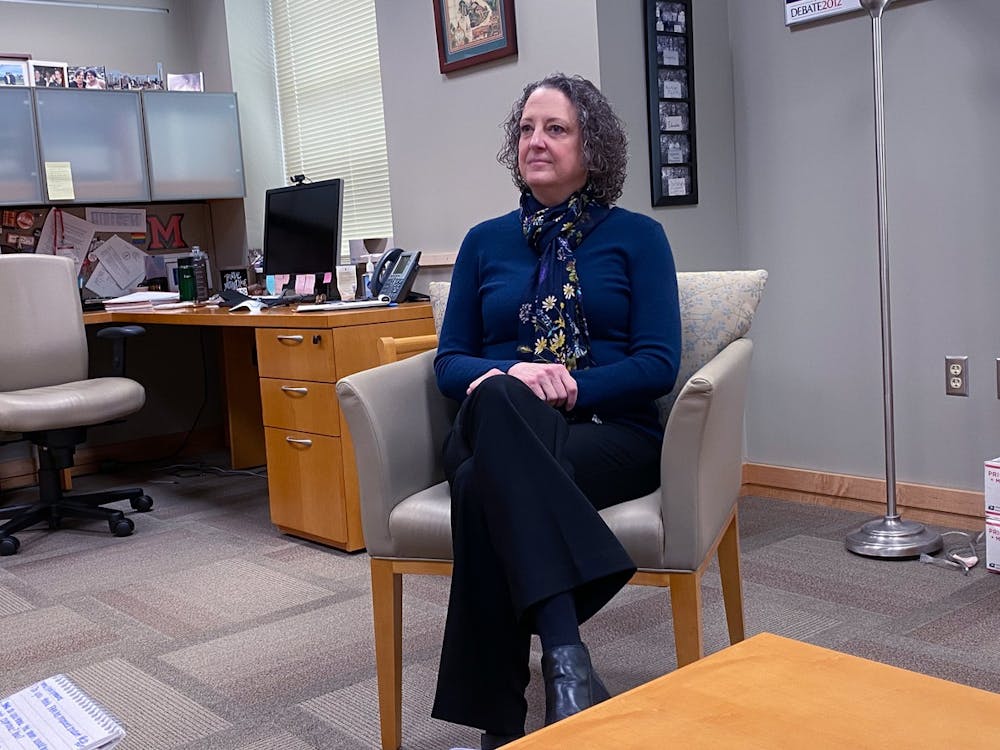Much of the attention surrounding the Faculty Alliance of Miami’s (FAM) efforts to unionize the faculty at Miami University has concentrated on administrators and professors alike; however, the faculty union won’t just affect those who receive a paycheck from the university.
The faculty union could have a significant impact on student experience and faculty engagement outside of the classroom.
Jayne Brownell, vice president for Student Life at Miami, said students are already reaching out to her with questions and concerns about a unionized faculty.
“I have had a number of students reach out to me being confused about what it means,” Brownell said, “so I think that there is some sense of anxiety because they don’t understand the process or understand how they might be involved or what the impact might be on them.”
Before her role at Miami, Brownell served as assistant vice president of student life at Hofstra University for eight years. Although Brownell was not a member, Hofstra has had a unionized faculty since 1973 as a collective-bargaining chapter of the American Association of University Professors (AAUP).
Brownell explained that from an administration perspective, the faculty union has substantial negative impacts on the student experience at Hofstra.
Hofstra faculty do teaching, research and service, but it has to be related to their academic department or Academic Affairs. Any other involvement on campus that professors take part in has to be compensated at a specific rate.
“If you had a specific rank,” Brownell said, “we were told what we had to pay for you to do anything outside the classroom as overload, and they were not allowed to volunteer their time.”
Because faculty couldn’t volunteer, Brownell said faculty involvement with student activities and organizations decreased significantly.
“We didn’t have the budget for it, so we just didn’t have faculty involved outside the classroom,” Brownell said.
When Brownell came to Miami in 2014, she noticed a significant difference in faculty involvement outside of the classroom that was missing from Hofstra.
“While I’ve been at Miami, I have asked our departments over time, ‘Let us know what faculty have been involved with your department so that we can thank them,’ and we have had upwards of 400 to 500 faculty a year get involved in student life,” Brownell said.
Enjoy what you're reading?
Signup for our newsletter
Brownell said she isn’t sure that a faculty union at Miami would have the same results that it did at Hofstra, but she emphasized the importance of faculty engagement already demonstrated at Miami.
“It doesn’t mean that that is exactly what it may look like here, but I can say that coming here was a much different experience in how engaged the faculty are in their students’ lives beyond their academic world,” Brownell said.
Cathy Wagner, president of FAM, disagrees with Brownell and feels there is already a disconnect between student engagement and faculty involvement.
Wagner said the university used to provide professional development funds to incentivize professors to engage with students in research, but the university has taken those funds away to allocate it towards other costs. Professors are no longer compensated for undergraduate research engagement, and many professors, including Wagner, volunteer their time to help students with research.
“It’s a significant loss for students that the university is taking money away from [research] and reducing student opportunity because there are going to be fewer professors who want to do it,” Wagner said.
Wagner said that by taking funding away from research opportunities and independent studies, the university is deterring faculty from working with students.
“Every professor I know wants to work with students and wants to work with them individually,” Wagner said. “... but do students really want professors to be doing more work than they’re being paid to do?”
Anne Roma, a professor of social work at the University of Cincinnati (UC), and a previous professor at Miami, is now in a faculty union herself, and said faculty involvement isn’t always determined by unionization. During her time at Miami, she had a hard time getting faculty to engage with activities outside of the classroom.
“I was [also] a direct graduate director, and I had a hard time getting one or two people to come [to events], not because they’re not good people, but because they are burnt out and tired,” Roma said.
Roma taught at Miami for five years but left at the end of the 2020-21 school year. She said being part of the faculty union at UC was a primary factor in her decision to leave Miami.
As a member, Roma said she received a significant salary increase, experiences better communication between administration and faculty and has the opportunity for promotions.
But the faculty union doesn’t just benefit her, Roma said. She noticed a large difference in student engagement between Miami and UC and said she feels more comfortable teaching at UC because the faculty union protects her and allows her to teach lessons that she feels best benefit student learning.
“[My job] is very delineated, which allows me to plan my classes and choose activities and do things in ways that benefit students,” Roma said. “It frees up my mind and my energy to be more present with them instead of worrying about what I need to do and how I need to do it.”
A faculty member in the Department of Media, Journalism, and Film (MJF) at Miami who preferred to remain anonymous agreed with Roma.
Before coming to Miami, she was a non-traditional doctorate student at a university where she studied under professors in the faculty union. Before earning her doctorate, she taught as a non-tenure-track (NTT) professor at another university. While there, the NTT faculty were not unionized, but she was heavily involved with unionization efforts.
With experience as a student under a unionized faculty and a professor working with unionized faculty, she said there is a noticeable difference in the comfort of teaching at Miami.
“The security offered by the unionization meant a lot to the faculty, and seeing the unionization process … with the non-tenure faculty … people were a lot more secure,” she said. “They felt a lot better. They knew what they were contracted to do.”
She also agrees with Roma that faculty engagement outside of the classroom is not related to the faculty union. She said at her previous institution, service obligations for unionized faculty were more outlined and clear, but that wasn’t necessarily the same for NTT faculty.
“Before the non-tenure folks were unionized, we would just volunteer for committees as we felt like it and figured that it would get put on our end-of-the-year reports, and we might get a little extra money … but there was no formalization of it,” she said.
Although Brownell encountered a different experience with faculty engagement at Hofstra, she said it is important to remember there are both benefits and drawbacks to faculty unions.
“The positive was that I felt like faculty were more visible,” Brownell said. “The negative was that a lot of people did things because they were required to and not because they bought into it.”
Brownell said her advice for FAM as it continues in its unionization efforts is to think about maintaining faculty engagement with students outside of the classroom in a financially realistic way.
“Think about how a contract could be written that still allows faculty to be a part of the fabric of the campus seven days a week, evenings, still involved with residence halls,” Brownell said, “but wouldn’t require additional compensation from partner offices because I know my budget won’t go up to allow that.”
Wagner said that if students are concerned about how a unionized faculty might affect them, to reach out, because she believes the faculty can’t unionize without student support.
“If there are things that students feel they need from their education, a union is one way to get that,” Wagner said. “I would encourage students to come talk to us about what they need, and we can work together and build a better Miami together.”
Wagner shared that FAM is currently trying to finish up collecting authorization cards and hopes to close the campaign soon. Once it has collected cards from at least 30% of the faculty, it will file for an official vote.




